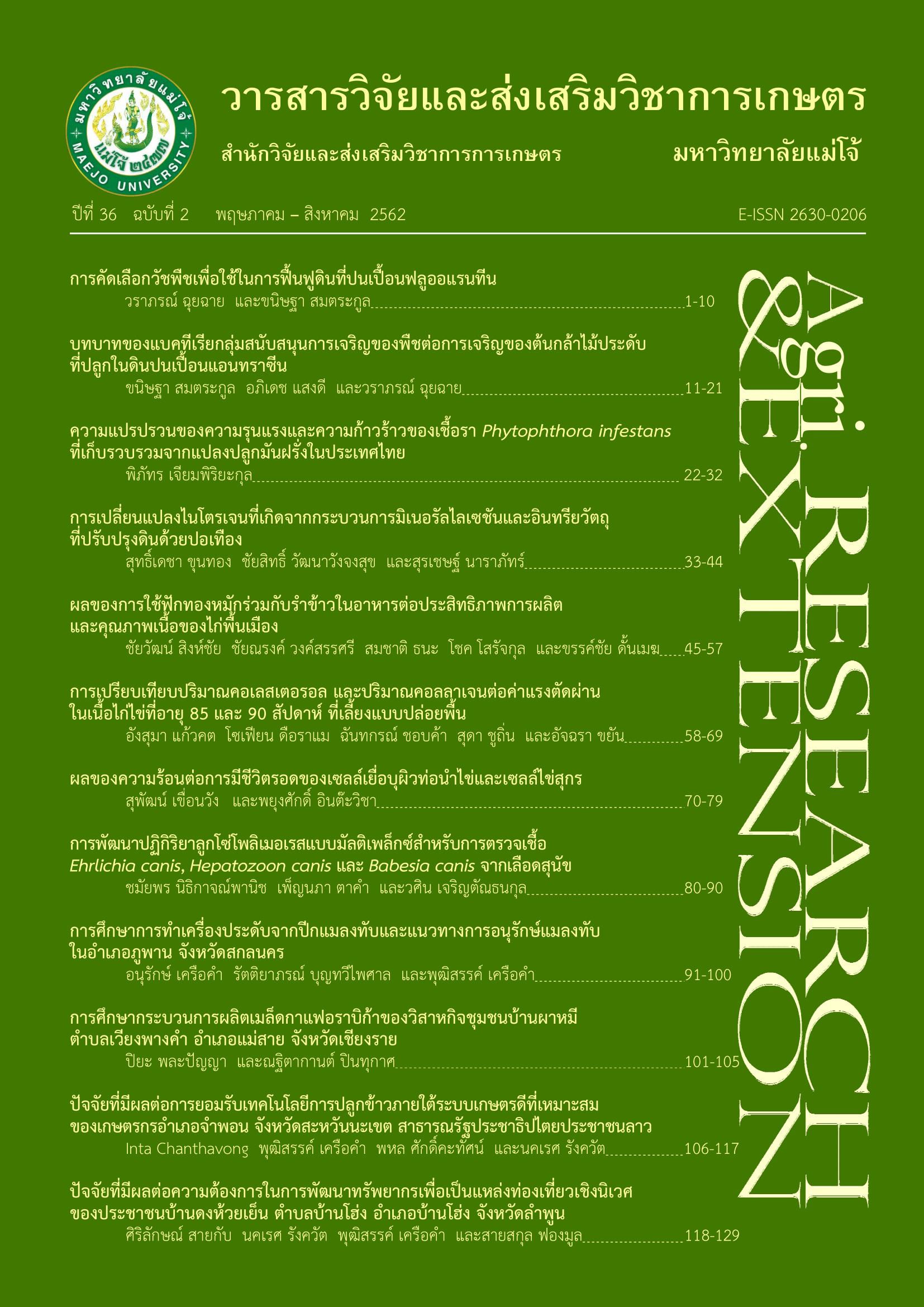ผลของความร้อนต่อการมีชีวิตรอดของเซลล์เยื่อบุผิวท่อนำไข่ และเซลล์ไข่สุกร
คำสำคัญ:
เยื่อบุผิวท่อนำไข่, เซลล์ไข่, ท่อนำไข่, สุกรบทคัดย่อ
งานวิจัยนี้มีจุดประสงค์เพื่อศึกษาอัตราการมีชีวิตรอดของเซลล์เยื่อบุผิวท่อนำไข่ และเซลล์ไข่ที่ได้รับอุณหภูมิร้อน (Exposed Heat Shock; EHS) ในหลอดทดลอง การศึกษาที่ 1 ศึกษาอัตราการมีชีวิตรอดของเซลล์เยื่อบุผิวท่อนำไข่ โดยใช้ท่อนำไข่ที่ถูกเก็บจากสุกรสาวทั้งหมด 18 ตัว แบ่งออกเป็น 6 กลุ่ม คือ กลุ่มที่ 1 EHS 38.5oซ 12 ซม., กลุ่มที่ 2 EHS 38.5oซ 24 ซม., กลุ่มที่ 3 EHS 40oซ 12 ซม., กลุ่มที่ 4 EHS 40oซ 24 ซม., กลุ่มที่ 5 EHS 42oซ 12 ซม. และกลุ่มที่ 6 EHS 42oซ 24 ซม. ผลพบว่า กลุ่มที่ 1 (99.09±0.68%) มีอัตราการมีชีวิตรอดสูงกว่า กลุ่มที่ 4 (97.45±1.43%)กลุ่มที่ 5 (95.90±2.29%) และกลุ่มที่ 6 (95.880±1.89%) ซึ่งแตกต่างกันอย่างมีนัยสำคัญทางสถิติ (P<0.01) แต่ไม่แตกต่างกันอย่างมีนัยสำคัญทางสถิติกับ กลุ่มที่ 2 (98.95±0.56%) และกลุ่มที่ 3 (97.59±1.31%) (P>0.01) การศึกษาที่ 2 ศึกษาการเพาะเลี้ยง COCs ร่วมกับเซลล์เยื่อบุผิวท่อนำไข่ที่ถูกฮีทช็อค ด้วยอุณหภูมิที่แตกต่างกัน รังไข่ถูกเก็บจากสุกรสาวทั้งหมด 300 ตัว ผลพบว่า มีการขยายของคิวมูลัส (Cumulus) เมื่อเลี้ยงไปถึงชั่วโมงที่ 44 ในกลุ่มที่ 1 (6.237±0.90 µm) มีค่ามากกว่ากลุ่มที่ 3 (5.86±0.88 µm),กลุ่มที่ 4 (5.853±0.90 µm), กลุ่มที่ 5 (5.862±0.95 µm) และกลุ่มที่ 6 (5.707±1.09 µm) ซึ่งแตกต่างกันอย่างมีนัยสำคัญทางสถิติ (P<0.01) แต่ไม่แตกต่างกันอย่างมีนัยสำคัญทางสถิติกับกลุ่มที่ 2 (6.210±0.93 µm) (P>0.01) และผลของอัตราการพัฒนาของเซลล์ไข่ไปจนถึงระยะ Metaphase II ในกลุ่มที่ 1 (67.21%) มีค่ามากกว่ากลุ่มที่ 2 (66.13%) กลุ่มที่ 3 (62.40%) กลุ่มที่ 4 (61.81% ) กลุ่มที่ 5 (62.10%) และกลุ่มที่ 6 (61.82%) ดังนั้นสรุปได้ว่า อุณหภูมิสูงส่งผลต่ออัตราการมีชีวิตรอดของเซลล์เยื่อบุผิวท่อนำไข่ และการขยายของเซลล์คิวมูลัส และการพัฒนาของเซลล์ไข่
เอกสารอ้างอิง
Chen, X.Y., Q.W. Li and J. Huang. 2007. Effects of ovarian cortex cell co-culture during in vitro maturation on porcine oocytes maturation, fertilization and embryo development. Anim. Reprod. Sci. 99(3-4): 306-316.
Fazeli, A., A.E. Duncan and W.V. Holt. 1999. Sperm–oviduct interaction: induction of capacitation and preferential binding of uncapacitated spermatozoa to oviductal epithelial cells in porcine species. Biol. Reprod. 60(4): 879-886.
Georgiou, A.S., E. Sostaric and H.D. Moore. 2005. A gametes alter the oviductal secretory proteome. Mol Cell Proteomics. 4(11): 1785-1796.
Kidson, A., E. Schoevers and M. Bevers. 2003. The effect of oviductal epithelial cell co-culture during in maturation on sow oocyte morphology, fertilization and embryo development. Theriogenology 59(9): 1889-1903.
Prunier, A., J.Y. Dourmad and M. Etienne. 1994. Effect of light regimen under various ambient temperatures on sow and litter performance. J. Anim Sci. 72(6): 1461-1466.
Romar, R., P. Coy and S. Ruiz. 2001. Effect of co-culture of porcine sperm and oocytes with porcine oviductal epithelial cells on in vitro fertilization. Anim. Reprod. Sci. 68(1-2): 85-98.
Wegner, K., C. Lambertz and M. Gauly. 2016. Effects of temperature and temperature-humidity index on the reproductive performance of sows during summer months under a temperate climate. J. Anim. Sci. 87(11): 1334-1339.
ดาวน์โหลด
เผยแพร่แล้ว
รูปแบบการอ้างอิง
ฉบับ
ประเภทบทความ
สัญญาอนุญาต

อนุญาตภายใต้เงื่อนไข Creative Commons Attribution-NonCommercial-NoDerivatives 4.0 International License.
บทความนี้ได้รับการเผยแพร่ภายใต้สัญญาอนุญาต Creative Commons Attribution-NonCommercial-NoDerivatives 4.0 International (CC BY-NC-ND 4.0) ซึ่งอนุญาตให้ผู้อื่นสามารถแชร์บทความได้โดยให้เครดิตผู้เขียนและห้ามนำไปใช้เพื่อการค้าหรือดัดแปลง หากต้องการใช้งานซ้ำในลักษณะอื่น ๆ หรือการเผยแพร่ซ้ำ จำเป็นต้องได้รับอนุญาตจากวารสาร





